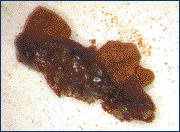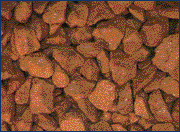Brent D. Johnson, Senior News Editor
In the deep, rich earth of Colombia's misted peaks grows the Coffea arabica tree. Thriving only in the high altitudes of the South American Andes mountains and in the shadow of Africa's Kilimanjaro, the highly prized fruit of the tree finds its way into the cups of millions of caffeine-lovers every day.

High-quality coffee tastes, smells and looks good. Technicians at Café de Colombia examine freeze-dried coffee grains for appearance defects, such as agglomerations.
What few java junkies appreciate, however, is the extraordinary scrutiny to which Colombian coffee beans are subjected. After the coffee berries are depulped, the beans are washed and passed through a filter to remove any twigs or foreign material. The washing also brings out the acid agents that  give the coffee its unique flavor. Then the beans are sun-dried. After they have been ground and processed for freeze-drying, the grains are about 2 to 4 mm across. At this stage, they undergo microscopic analysis to ensure a uniform consistency.
give the coffee its unique flavor. Then the beans are sun-dried. After they have been ground and processed for freeze-drying, the grains are about 2 to 4 mm across. At this stage, they undergo microscopic analysis to ensure a uniform consistency.
For freeze-dried coffee, both taste and appearance are important. Before giving the coffee a certificate of quality, companies inspect it chemically, organoleptically (by taste, color, odor and feel) and physically, including for size and shape.
Paula Andrea Jaramillo-Henao of Café de Colombia in Chinchina, Colombia, said that three shifts work around the clock, looking at coffee particles through stereomicroscopes.
"We analyze if the particles have narrow edges, because that can make the grain less resistant and will produce more fine particles in the final packed product," Jaramillo-Henao said. "But the important part is that we do 'reject' the coffee for its physical appearance as bubble grains, melted grains, brilliant grains, agglomerated grains."
As she describes it, the procedure is very tiring. Yet, despite efforts to find an improved technology, the system had remained unchanged for 20 years.
Café de Colombia had considered using a system that could be adapted to its old lenses and run with Lucia Software, but when company officials saw a 3-D Inspection Station from Hi-Scope Systems Co. of Closter, N.J., at an international exhibit, they decided that it was the best option for their application. The three-dimensional rotational lens allows them to visualize the grains much better, and the software helps them to train analysts and to keep records on their product.
"It gave us a big solution," Jaramillo-Henao said. "This equipment helped us ... to guarantee the quality of the freeze-dried coffee, because we can instantly detect particles different from coffee, giving us the time to make a product free from any strange particles."